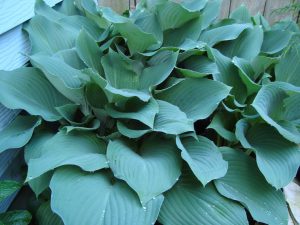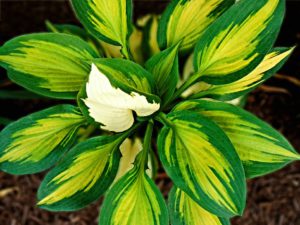How to Successfully Grow and Care for Hosta Plants

Hosta has been traced back as far as 800 years growing in China’s shady forest, there are said to be about 40 species of these perennial beauties that belong to the family Asparagaceae. Some species and cultivars are grown for their beautiful foliage (Leaves) which range in colors from variegated, yellow, light-to-dark green, or blue.
The hosta plant has left its mark and found its way into the hearts of many gardeners from the amateur to the professional, these garden beauties can thrive either in partial or full shade, what I love about hosta is the beautiful flowers which are produced, the variegated foliage is an added bonus that will provide that much-needed color.
Hosta comes in many shapes, sizes, and textures, there are said to be 2,500 cultivars which is a wide selection to choose from, installing hosta in your outdoor or indoor living space will brighten your day, with a hosta plant your work will be made easy as these garden beauties are so simple to grow and maintain. For more on how to grow and care for hosta continue reading and find out why the hosta plant has caught the attention of persons from all walks of life.
Planting Location
Hosta thrives best in the partial-full shade so ensure this requirement is met.
Soil Type
The soil type should be soil that drains well and slightly acidic, the use of compost or organics is great for amending the soil.
Hosta watering methods
Although hosta can thrive under drought conditions it is best to keep them well watered, allow the soil to dry out somewhat before giving them another drink.
Hosta fertilizing methods
In the spring through early summer fertilize your hosta with a quick release or water-soluble fertilizer. Before applying fertilizers read and follow the manufacture’s directions for best results.
Garden insect pests of hosta
The hosta plants have their share of garden pests.

- Aphids
- Whiteflies
- Slugs and Snails
- Voles
- Rabbits
- Squirrels
- Deer
- Cutworms
- Grasshoppers
- Blister Beetles
Aphids
Aphids are soft-bodied insect pests that suck the sap from garden plants, these insect pests love the tender shoots and excrete a sticky substance known as honeydew which black molds form causing garden plants to take on a sickly appearance. To bring aphids under control the use of horticulture oil or insecticidal soap will offer some help.
Whiteflies
Whiteflies are tiny white-winged insect pests that dose the same damage as aphids. When whiteflies are disturbed they will dislodge from plants but then reattach just as quickly, control whiteflies as you would aphids.
Slugs and Snails
Slugs and Snails cause damage by eating the plant’s leaves, leaving holes and chewed ends, to bring under control the use of snail bait, handpicking and throwing them into a bucket of soapy water, sprinkling coffee grounds, Epsom salt, or crushing dry eggshells around the base of your plants is effective. An added benefit with eggshells is that as it decomposes adds nutrients to the soil.
Voles
Voles cause damage by digging and tunneling into the soil look for roots, or wilting plants. Keep the planting bed free of debris and weeds. Bury steel mesh around your plants rising it several inches above your plants.
Rabbits
Rabbits also cause their share of damage but the good news is you can always strike back to keep them at bay. The use of sprinkling red powdered pepper around your garden, placing a two or three feet fence around your hosta, purchase rabbit repellents, installing a motion sensor sprinkler system, or plant what they love to eat in a different location as a distraction from your hosta.
Squirrels
Squirrels cause damage by digging up plants, to keep them at bay the use of a motion sensor sprinkler or sprinkling cayenne pepper on the leaves will offer some help.
Deer
Deers will eat the leaves of garden plants leaving the stalk causing plants to look unattractive. The use of organic animal repellents, motion sensor sprinklers, own a dog, and letting him run freely will give deer a scare, etc…
Grasshoppers
Grasshoppers may pose another threat to your hosta, these garden insect pests move from plant to plant by jumping or hopping. Grasshoppers can be naturally controlled by birds, frogs, cats, or toads. The use of insecticidal may also offer some help especially if they are caught at the young stage.
Blister Beetles
There are said to be more than 2,500 species that can become a nuisance to garden plants including hosta. Control these beetles by handpicking and dropping them in a bucket of soap and water. Wearing strong hand gloves will protect you from their bite, spreading diatomaceous earth around plants or spinosad may offer some help.
Cutworms
Cutworms are the larval stage of moths, these larvae dose damage by cutting through plant stem at the base. They feed on the foliage and roots of young plants which will cause the top growth to shrivel and die. Different species of cutworms are of different colors and tend to curl up when they are not feeding.
They are very active during nighttime but remain hidden during the day. Control these garden pests by going into your garden with a flashlight during night hours handpicking and throwing them into a bucket of soapy water, make sure you are wearing hand gloves. Sprinkling diatomaceous earth around the base of hosta plants in a circular pattern will bring them under control, the use of eggshells and coffee grounds around hosta has proven to be effective also Bacillus thuringiensis will bring cutworms under control but may affect beneficial insects.
Diseases of hosta
Common hosta diseases to keep an eye out for
- Sooty Mold
- Crown Rot
- Nematodes
- Hosta Virus X
Sooty Molds
Sooty molds are a dark mass that covers the leaves and in serve cases the steams of garden plants, these molds develop from the secretion of sucking insects such as mealybugs, whiteflies, aphids, etc… the secretion of these garden insect pests is known as honeydew. Sooty molds interfere by blocking the sunlight in which garden plants need to produce their food. To bring sooty mold under control garden insect pests must first be dealt with. Pesticides such as insecticidal soap or horticultural oil will offer great help.
Crown Rot
Crown rot appears in late spring, stems at the ground level show a dark brown or black decay, the leaves also turn yellow and then brown followed by leaf drop. Plants with this fungal disease should be removed and discarded immediately.
Nematodes
Nematodes are worms that can cause much damage to plant life, nematodes inhabit the soil or can be found feeding on the inside of the hosta leaves. Symptoms of nematode infestation include, the leaves losing their color turning brown followed by brown streaking between the veins.
This brown in time will spread to the entire leaf followed by leaf drop, to avoid this issue the leaves should be dry at all times which means water your hosta from the ground or soil level.
Hosta Virus X
Hosta virus x shows up as light or dark green discoloration along the leave’s vein. The leaf blades molt turning green and yellow, as this disease progress, the plant begins to wilt because of dying tissues. This disease can spread to healthy plants by using infected garden tools such as pruners, knives, shovels, etc…
There is no known treatment for this disease except to uproot infected plants and properly disposed of them by burning, don’t use infected plants as compost because this will cause contamination. Before purchasing hosta plants do a thorough inspection also talk to growers to ensure you’re getting healthy plants, avoid plant injury because cuttings can encourage this disease, and remember to sanitize all tools when working with plants. Tools that are cleaned with bleach and water before and after each pruning procedure is a must.
Ideas where to install hosta
Here a just a few places to install hosta, ensure the area they are planted in gets partial-full shade.
1. Install in containers and place the containers on your patio or porch.
2. Containers can be installed around your pool area.
3. Grow hosta from containers and place containers indoors.
4. Place hosta in a garden bed ensuring that area gets partial-full shade.
5. Install them in containers and place the containers on either side of your door entrance.
Container grown hosta
Container-grown hosta is another great way to grow and care for hosta. The containers which are used should have drain holes for excess water to escape. The soil should be a good garden soil that is organic-rich, once your hosta is potted up place it in an area that gets full-partial shade. Fertilize, water, and treat them for garden insect pests and diseases as stated earlier.
Growing hosta indoors
After you have potted your hosta plant and ready to bring indoors look for an area that gets full indirect sunlight. When checking the soil a probe or soil moisture meter will get the job done if you don’t have either then your finger will do, place your finger about one to two inches in the soil if the soil is dry then water. The soil should be somewhat moist and not waterlogged when it comes to the temperature it should be moderate heat.
The final word
Hosta plants are so easy to care for, this garden beauty can work wonders both out and indoors if you are looking for a plant that adds colors and not fussy then the hosta plant makes the right fit, I am sure you will be happy as you enjoy the beauty and flavor they bring to your outdoor or indoor living space.
About the author
Norman loves being in the garden, both at home and for his job....
he is 'Natures Little helper' being outdoors, growing his vegetables and flowers from an early age.
Now having spent over 22 years in the profession he want to give some of his knowledge to others...
his vast array of hints and tips you will find scattered over this site will help you no end growing plants in your garden.

I am so glad that I found this site as I see you have a lot of information about various plants and where they grow best. I am terrible at gardening, and I just seem to choose the wrong plants, as they all seem to die on me.
I see with Hosta they need partial shade. My garden is mostly sun all over, so I need to find plants that are hardy and withstand the dryness. I bought about a whole lot of plants at the nursery a few weeks ago, and they said full sun and don’t need much water. Well only one has survived so far.
Any suggestions?
Hello, I am so happy to help, so sorry to hear of your plant issues, when growing and caring for plants it is all a matter of knowing how and you will be well on your way to garden success. Before purchasing plants just do research on all that is needed to keep that plant growing healthy and you are good to go hope this helps. A good resource to check is https://gardenofedengardencent…
This sounds like a fun plant to work with, and I never thought about being able to spread plant diseases through your tools before. I’m pretty new to gardening myself, but I would love to get a nice garden going. I do live in a colder climate though, how well do these plants do in the cold? Also, are they easy to keep alive indoors?
I am so happy to help and yes these plants can be grown easily and can be grown indoors. Hopes this helps, refer to this link. https://gardenofedengardencent…